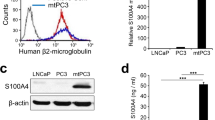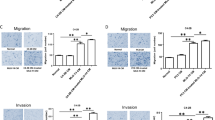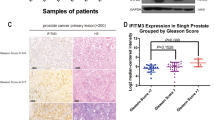Abstract
We sought to study the effects of PI3K/Akt pathway and its downstream substrate NF-κB on prostate cancer bone metastatic process. Expression level of active p-Akt in PC3 cells was upregulated by transient expression with constitutively active plasmid CA-Akt or, alternatively, suppressed by dominant negative construct DN-Akt. NF-κB activity was determined by luciferase reporter assays. mRNA and protein expressions of receptor activator of NF-κB ligand (RANKL), parathyroid hormone-related protein (PTHrP), and bone morphogenetic protein 2 (BMP-2) were evaluated using RT-PCR and Western blotting. The effect of cross-talk between PC3 and SaOS2 cells on cell proliferation was analyzed using a co-culture system. Stimulation of p-Akt promoted NF-κB activity, and led to an increase in mRNA and protein expressions of RANKL, PTHrP, and BMP-2 in PC3 PCa cells through NF-κB. Co-culturing PC3 and SaOS2 cells significantly increased the expression of p-Akt and the activity of NF-κB, and promoted proliferation of both PC3 and SaOS2 cells. Increasing expression levels of p-Akt by transfection with CA-Akt led to further increase in cells proliferation, whereas NF-κB inhibitor PDTC partially blocked this effect. PI3K/Akt pathway stimulates the expressions of RANKL, PTHrP, and BMP-2 partly through NF-κB, suggesting its importance for bone metastasis of prostate carcinoma. Interaction of prostate cancer cells with bone cells has a stimulatory effect on cell proliferation.




Similar content being viewed by others
References
Coleman, R. E., Rathbone, E., & Brown, J. E. (2013). Management of cancer treatment-induced bone loss. Nature Reviews Rheumatology, 9(6), 365–374.
Casimiro, S., Mohammad, K. S., Pires, R., et al. (2013). RANKL/RANK/MMP-1 molecular triad contributes to the metastatic phenotype of breast and prostate cancer cells in vitro. PLoS One, 8(5), e63153.
Roodman, G. D. (2012). Genes associate with abnormal bone cell activity in bone metastasis. Cancer and Metastasis Reviews, 31(3–4), 569–578.
Park, S. I., & McCauley, L. K. (2012). Nuclear localization of parathyroid hormone-related peptide confers resistance to anoikis in prostate cancer cells. Endocrine-Related Cancer, 19(3), 243–254.
Liao, J., & McCauley, L. K. (2006). Skeletal metastasis: Established and emerging roles of parathyroid hormone related protein (PTHrP). Cancer and Metastasis Reviews, 25, 559–571.
Kwon, H., Kim, H. J., Rice, W. L., et al. (2010). Development of an in vitro model to study the impact of BMP-2 on metastasis to bone. Journal of Tissue Engineering and Regenerative Medicine, 4(8), 590–599.
Cao, J., Zhu, S., Zhou, W., et al. (2013). PLZF mediates the PTEN/AKT/FOXO3a signaling in suppression of prostate tumorigenesis. PLoS One, 8(12), e77922.
He, W., Zhang, M. G., Wang, X. J., et al. (2013). KAT5 and KAT6B are in positive regulation on cell proliferation of prostate cancer through PI3K-AKT signaling. International Journal of Clinical and Experimental Pathology, 6(12), 2864–2871.
Ellis, L., Ku, S. Y., Ramakrishnan, S., et al. (2013). Combinatorial antitumor effect of HDAC and the PI3K-Akt-mTOR pathway inhibition in a Pten defecient model of prostate cancer. Oncotarget, 4(12), 2225–2236.
Taylor, B. S., Schultz, N., Hieronymus, H., et al. (2010). Integrative genomic profiling of human prostate cancer. Cancer Cell, 18, 11–22.
Kreisberg, J. I., Malik, S. N., Prihoda, T. J., et al. (2004). Phosphorylation of Akt (Ser473) is an excellent predictor of poor clinical outcome in prostate cancer. Cancer Research, 64(15), 5232–5236.
Yang, J., Fizazi, K., Peleg, S., et al. (2001). Prostate cancer cells induce osteoblast differentiation through a Cbfal-dependent pathway. Cancer Research, 61, 5652–5659.
Bussard, K. M., Gay, C. V., & Mastro, A. M. (2008). The bone microenvironment in metastasis; what is special about bone? Cancer and Metastasis Reviews, 27, 41–55.
Autio, K. A., & Morris, M. J. (2013). Targeting bone physiology for the treatment of metastatic prostate cancer. Clinical Advances in Hematology & Oncology, 11(3), 134–143.
Rajpar, S., & Fizazi, K. (2013). Bone targeted therapies in metastatic castration-resistant prostate cancer. Cancer Journal, 19(1), 66–70.
Roodman, G. D. (2004). Mechanisms of bone metastasis. New England Journal of Medicine, 350, 1655–1664.
Downward, J. (1998). Mechanisms and consequences of activation of protein kinase B/Akt. Current Opinion in Cell Biology, 10, 262–267.
Cantley, L. C., & Neel, B. G. (1999). New insights into tumor suppression: PTEN suppresses tumor formation by restraining the PI3K/Akt pathway. Proceedings of National Academy of Sciences, 96, 4240–4245.
Hay, N., & Sonenberg, N. (2004). Upstream and downstream of mTOR. Genes & Development, 18, 1926–1945.
Dan, H. C., Cooper, M. J., Cogswell, P. C., et al. (2008). Akt-dependent regulation of NF-{kappa}B is controlled by mTOR and Raptor in association with IKK. Genes & Development, 22(11), 1490–1500.
Wei, X., Zhou, D., Wang, H., et al. (2013). Effects of pyridine analogs of curcumin on growth, apoptosis and NF-κB activity in prostate cancer PC-3 cells. Anticancer Research, 33(4), 1343–1350.
Setlur, S. R., Royce, T. E., Sboner, A., et al. (2007). Integrative microarray analysis of pathways dysregulated in metastatic prostate cancer. Cancer Research, 67, 10296–10303.
Ahmed, A. (2010). Prognostic and therapeutic role of nuclear factor-kappa B (NFkappaB) in breast cancer. Journal of Ayub Medical College Abbottabad, 22, 218–221.
Esposito, M., & Kang, Y. (2014). Targeting tumor-stromal interactions in bone metastasis. Pharmacology & Therapeutics, 141(2), 222–233.
Wen, H., Feng, C. C., Ding, G. X., et al. (2013). Med19 promotes bone metastasis and invasiveness of bladder urothelial carcinoma via bone morphogenetic protein 2. Annals of Diagnostic Pathology, 17(3), 259–264.
Graham, Tisheeka R., Odero-Marah, Valerie A., Chung, Leland W., et al. (2009). PI3K/Akt-dependent transcriptional regulation and activation of BMP-2-smad signaling by NF-κB in metastatic prostate. Cancer Cells, 69(2), 168–180.
Graham, Tisheeka R., Agrawal, Krishna C., & Abdel-Mageed, Asim B. (2010). Independent and cooperative roles of tumor necrosis factor-α, nuclear factor-κB, and bone morphogenetic protein-2 in regulation of metastasis and osteomimicry of prostate cancer cells and differentiation and mineralization of MC3T3-E1 osteoblast-like cells. Cancer Science, 101(1), 103–111.
Shi, J., Chen, J., Serradji, N., Xu, X., et al. (2013). PMS1077 sensitizes TNF-α induced apoptosis in human prostate cancer cells by blocking NF-κB signaling pathway. PLoS One, 8(4), e61132.
Owens, P., Polikowsky, H., Pickup, M. W., et al. (2013). Bone morphogenetic proteins stimulate mammary fibroblasts to promote mammary carcinoma cell invasion. PLoS One, 8(6), e67533.
Brennen, W. N., Chen, S., Denmeade, S. R., et al. (2013). Quantification of mesenchymal stem cells (MSCs) at sites of human prostate cancer. Oncotarget, 4(1), 106–117.
Li, X., Sterling, J. A., Fan, K. H., Vessella, R. L., et al. (2012). Loss of TGF-β responsiveness in prostate stromal cells alters chemokine levels and facilitates the development of mixed osteoblastic/osteolytic bone lesions. Molecular Cancer Research, 10(4), 494–503.
Acknowledgments
This study is supported by ① the Projects for Construction of Key Disease Category of Integrated Traditional Chinese and Western Medicine, Shanghai (zxbz2012-02); ② the Innovation Fund Projects for Top Discipline of Integrated Traditional Chinese and Western Medicine (Shanghai University of Traditional Chinese Medicine); and ③ the Advanced Talent Cultivation Projects of Integrated Traditional Chinese and Western Medicine, Shanghai (ZYSNXD012-RC-ZXY013).
Author information
Authors and Affiliations
Corresponding author
Rights and permissions
About this article
Cite this article
Zhu, W., Hu, X., Xu, J. et al. Effect of PI3K/Akt Signaling Pathway on the Process of Prostate Cancer Metastasis to Bone. Cell Biochem Biophys 72, 171–177 (2015). https://doi.org/10.1007/s12013-014-0433-3
Published:
Issue Date:
DOI: https://doi.org/10.1007/s12013-014-0433-3




